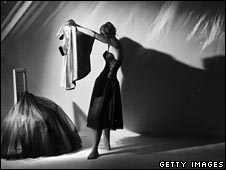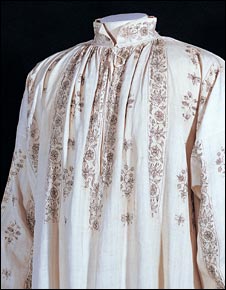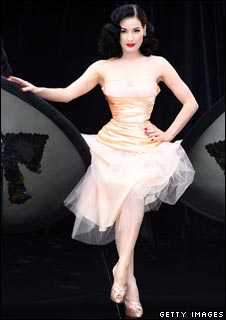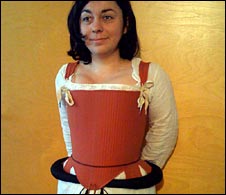|
Elaborate bra straps. Designer trunks riding above low-slung jeans. The fashion for flaunting one's underwear may have more to do with conspicuous consumption than a decline in decency, says Lisa Jardine.
When I was at school, the whispered warning "Charlie's dead" alerted a girl to the fact that her petticoat was showing under her lovat-green school skirt. Horror of horrors!

Today the petticoat alone would suffice
|
From the age of 11 we all knew that our underwear ought never to be visible - a flash of white below the skirt-line was both an embarrassment, and potentially the occasion for a reprimand from a school prefect.
There are various theories as to where that curious phrase came from. It seems to date from World War II, and my own favourite explanation is that in the 1940s, the window-blinds were lowered whenever there was a death in the house.
The dipping half-slip was like a lowered window-shade. More fanciful versions involving Bonny Prince Charlie or Charles II, are, I am afraid, historically implausible, though no doubt a number of listeners will write or e-mail me to say that they prefer them.
Until relatively recently, visible bra straps were treated as a sign that the wearer was, if not actually a fallen woman, at least someone who took insufficient care with her appearance - a likely symptom of slack behaviour in other areas of her life.
A student of mine whose mother ran a fancy lingerie shop in Delhi once told me that her mother's customers were not prepared to buy silk camisoles with spaghetti straps because the maid who laundered them would consider them - and therefore their owner - scandalous.
 |
 I am sure there are those who mutter that flamboyant, underwear-exposing fashions are further evidence of a general decline in morals
I am sure there are those who mutter that flamboyant, underwear-exposing fashions are further evidence of a general decline in morals

|
There could hardly be more of a contrast with fashions in underwear, and acceptable attitudes towards its display in public, in the era of consumer affluence we have been living through, these past 10 years.
It has been a time for ostentatiously showing off surplus wealth. And one of the signs that a woman has money to spare has been for her to let beautiful, expensive items of underwear show. Lavish lingerie departments have blossomed in department stores across the country.
The impulse not to keep a prize purchase hidden from view has been reflected in the design of fashion too - from High Street to haute couture. On the catwalks at this year's London Fashion Week, layering of diaphanous garments, with equally gorgeous underskirts and bodices, left nothing at all about the underwear beneath to the imagination.
Good for the goose...
This modern fashion trend, which seems to us to reflect our more easy-going attitudes to our bodies, is strikingly similar to the layering and glimpsing of undergarments of English 16th and early 17th Century costume.

Embroidered undershirt for men
|
This week sees the posthumous publication of the fourth volume in the great costume historian Janet Arnold's meticulously detailed series, Patterns of Fashion.
Having documented every item of outer clothing for the period, Arnold has turned her attention to Tudor and Stuart underwear. The book is sumptuously illustrated with photographs of surviving items of the clothing our forebears wore next to the skin, including gorgeous detail of lavish embroidery, lace-work and stitching. And it shows clearly the ways in which men and women of substance also enjoyed letting their expensive underwear show.
Indeed, the most striking difference between underwear-flaunting then and now seems to have been that in Tudor times, it was not only women, but men too who adopted fashion designs which allowed them to reveal their undergarments.
The process by which this gradual uncovering happened over time is fascinating.
The woman's smock and man's shirt, made of linen, were originally very similar garments - calf-length and long-sleeved, with a simple neck-opening. Worn next to the skin and washable, they protected the layers of finer fabric above from the wearer's sweat and dirt.
Linen underwear offered a practical way of being hygienic while wearing outer garments of heavy expensive cloths, richly embroidered and adorned with jewels which could never safely be cleaned.
Over the shirt the man wore a structured doublet, over her smock the woman wore a bodice - or pair of bodies, as it was called then - with inserted strips of stiffening.
The woman's layers of petticoats, underskirts and farthingales were attached to her bodice by "points" (ornamental ties) drawn through purpose-made eyelets, as were a man's hose or leggings.
These conjoined undergarments provided a base armature on which the sumptuous outer garments were displayed to produce an imposing, sharply defined, tailored shape to the ensemble.
Like my ruff?
Over time, the shirts and smocks of the wealthy came to be made of finer and finer linen, and were decorated with increasing lavishness at neckline and cuff.

The bra has come out from under
|
The fashionable neck frill and gathered cuffs used more and more linen, so that special starching and setting were required to make them sit more tidily around the garment's neckline. They were eventually separated from the undershirt or smock entirely, for ease of washing and maintaining, and evolved further in decorative lavishness as garments in their own right.
The neck frill grew oversized, into the elaborate, face-framing ruffs which for many of us define late Tudor dress, as it features in any number of formal portraits of royalty and nobility. Starching these became a laundry skill in its own right - the very first specialist ruff-launderer in England is supposed to have been a Flemish woman, Mistress Dingen Van der Passe, who brought Dutch-standard starching to London in 1564.
Detached ruffs and decorative cuffs were securely attached to the outer garments for each wearing, using metal pins. It has been suggested that in economic terms, these pins are the first genuinely disposable commodities of emerging consumer culture, since they were bought in bulk, used once and then discarded (though there are records of the more frugal having their bent pins straightened for re-use).
Even without integral layered and embroidered neck-frills and cuffs, the amount of coloured embroidery on the upper part of shirt and smock continued to grow, transforming the simple undergarment into an object of beauty in its own right.

A Tudor-era bodice, with a roll to hold the skirt out suggestively at the back
|
At a workshop on Tudor underwear I attended last week, run by the Early Modern Dress and Textiles Research Network, it was suggested that once these items of clothing were decorated with silver and gold thread-work - so they became both uncomfortable next to the skin, and difficult to launder - another, simpler smock or shirt had to be worn beneath them, adding further to the layering.
As the shirt and smock grew more highly-decorated, ornamental openings were slashed in men's doublets and women's gowns to allow the wearer to show off the beauty of the embroidered blackwork on their underwear. Loose outer gowns, kirtles and waistcoats enabled women to offer revealing glimpses of the elegant structuring of their underwear corsetry.
Austerity measures
I am sure there are those who mutter that recent flamboyant, underwear-exposing fashions are further evidence of a general decline in morals and decency.

The Virgin Queen flaunts her wealth
|
The close equivalence of fashions worn in the Tudor period suggests otherwise. The women who wore the extraordinarily smock- and undershirt-revealing styles of the late 16th century had to be seen as paragons of virtue by all. No well-born woman could risk being construed as provocative on the basis of what she wore.
Yet fashionable Tudor ladies were as be-ruffed and cuffed, and parading of their embroidered underwear, as their male counterparts. Take a close look at any of the many familiar, exquisitely detailed portraits of Queen Elizabeth I, and you will quickly spot the heavily embroidered smock glimpsed beneath her bodice, the hints of lace at throat and wrist, betokening lace-edged and finely stitched needlework under her bejewelled gown.
What Tudor fashions share with more recent styles is the ostentatious display of garments on which the wearer has lavished significant sums of money. In both cases the expensive item is clearly a frippery - an unnecessary extravagance announcing that the person wearing it has extra cash to spend.
I wonder whether, in the current financial climate, as frugality returns, it will once again become unseemly to display an elaborately embroidered bra, or show net petticoats under a twirling skirt?
The whispered warning "Charlie's dead" dates from a previous age of austerity, after WWII. According to the Governor of the Bank of England, we stand poised once again on the brink of a recession.
If things go as badly as the predictions of the gloomiest pundits suggest, will it soon be the case that women once again begin to alert one another to the danger of an immodest glimpse of petticoat?
Below is a selection of your comments.
The article states that the most striking difference between now and Tudor times is that then men flaunted their underwear. This is not entirely accurate; look at the number of youths, my son included, who today wear their jeans low enough to show off expensive shorts or other underwear. I would never have dreamt of letting my tatty Woollies Y-fronts be displayed.
Nigel, Lytham St Annes
At the sight of someone's petticoat beneath their skirt we always shouted "It's raining in Paris!". I never know why though...
Sarah, Glasgow, Scotland
I remember a movie from about 1947, maybe The Bachelor and the Bobby-soxer with Cary Grant, Myrna Loy, and Shirley Temple, in which one of the women stands in front of a mirror, sees her slip is showing, and says, "Charlie's dead." The other woman looks puzzled and gets the answer, "My slip's showing." I was in third grade at the time; one day, my teacher's slip was showing, and I said, "Charlie's dead," and, of course, she asked what I meant. I could get myself into trouble with very little effort.
Tim Cole, Porter County, Indiana, USA
We used to say "It's snowing down south".
Beryl J Sutherland, Broadstairs
In the 60s the American equivalent of "Charlie's dead" was "It's snowing down south". I had totally forgotten that one. The last time I wore a slip, Jimmy Carter was our president and gas was 30 cents a gallon.
Debbie Hughes, Florida, USA
Flaunting expensive clothing and shamelessness are not the same. There is a sense of feminine honour that has been all but eradicated over the last few decades, and that's a disaster. This is due to a shift away from religion and family values. What people are wearing today is a reflection of their moral values, irrespective of the price tag. As a Muslim, I enjoy good fashion, at home with my husband, among my female circle of friends, and under my conservative abaya. I feel no need to flaunt expensive underwear to any other than my other half.
Tina, UAE
To think that underwear exposure indicates moral decline is to disregard the evolution of fashion and culture. Of course, some changes are not liked by everyone. I, for one, feel like coming up behind these lads whose jeans are practically falling down, showing most of their underpants, and either pulling them up or yanking them right down. That, or walking along side them and saying, in a chirpy tone, "You so remind me of Dick Van Dyke and the penguin dance in Mary Poppins."
Wendy, Oxford
I am a 15 year old girl, and personally find the fashion for young men to wear their trousers low very attractive. That fashion in particular was created in poor areas of America, where boys would wear big clothes to indicate the size of their older brother or brothers - as many clothes would have been hand-downs - and thus protect them to a degree from predators. So this trend does not stem from wealthy extravagance, but from the fears of the poor. Whether this represents the decadence of modern society or not is a different matter entirely.
Louisa, London
When I was growing up in the US in the 70s, there was the mocking taunt "I see London, I see France, I see (insert name here)'s underpants". I would guess this has fallen into disuse considering the modern fashion.
Chris Wiggins, Paris, France
I have long wondered why people bought expensive lingerie when they could not display it. It was high time such an obvious shortcoming was remedied. A confident women can brave a passing recession to revive an "honest" style. Actually, it could be a statement of grit and defiance in these gloomy times.
Swaroop, Mysore, India
I can only quote the lovely Denis Leary - "There's a reason it's called UNDERwear."
Carolyn Middleton, Aberdeen, Scotland
I don't think that women show off their bra to show off their undergarments. I often wear clothes with my bra straps visible, but I don't do it to show off my bra, or my "expensive" purchase. My bra straps are often visible because I don't care to hide them - that's different than wanting to show it off. I wear a bra, and everybody knows that I and most other women are wearing bras, so why pretend like it's not there?
Allison, Louisville, US
I remember the time I realized how accepted showing our undergarments is when I was in school and one girl came into class and said to another, "Oh, I love your bra!" That is a compliment that I doubt my mother paid her friends.
Anne, USA
I guess one very important part is missing from this essay: the angle on construction of sexual desires through embodied objects. As much as an underwear is a piece of clothing, it is also a piece of intimate experience in sexual act.
Ab, Toronto, Canada
I was involved with competitive figure skating for many years. The kiss of death for a female skater was even if a minute glimpse of knickers was visible to the usually middle aged female judges who would mutter in near-unison the dreaded word "laundry".
Anon, Waterloo, Ontario, Canada
Oh please. If my underwear shows, it's because every pair of jeans on earth right now are cut too low and I can't seem to find any that sufficiently cover my bum. Every woman I know has given up on finding a decent fitting pair of jeans. Since when is 8.5" a "high rise"? Baloney. All of this in-depth analysis sort of missed the very obvious point: We wear low slung pants because we have no choice.
Maya, New York
This article conveniently excludes men from its analysis, a ridiculous oversight when considering the growing acceptance of street culture over the past decade. Both men and women are exposing their underwear in a mainstream setting, not as a show of wealth, but as a celebration of urban culture.
Kyle, London, Canada
There is perhaps room here to mention externally worn titillations, the most memorable of which is the cod-piece of Tudor males.
Malcolm Stewart-Morris MD
The reason you never hear the archaic phrase "your slip is showing" is they are not worn. For nearly 15 years women and girls in Canada have not been wearing dresses or skirts, let alone petticoats or slips. The only clothing you see young women wearing are denim trousers. I hazard to guess they wear men's briefs - this is only an educated guess. It would be nice to see a return to femininity.
Michael Collison, Surrey, Canada
This article represents one of the most convoluted excuses I have heard yet for showing off your underwear. I have no knowledge of Tudor times and what their reasons were for showing off their undergarments, but I do know that the main (but not necessarily only) reason anyone shows off their underwear today is to get attention from the opposite sex. I am always amazed at by how long it takes before a woman will admit to this, probably because the modern woman is not supposed to have to rely on such a blatant tactic. However it does work. But to suggest that women showing off their underwear is for a reason other than male attention is self-deluding.
Euan, San Francisco, USA
No mention of the fashions of Jane Austin's time, a serious amount of cleavage, fabrics that hardly needed to be wet to be see through and not much in the way of underwear. No wonder the girls needed constant supervision.
Simon Mallett, Lenham, Maidstone
My comment on The Tudors TV series was that the women show too much hair and not enough linen.
Kate Bunting, Derby, England
Dress has always been a fascinating indicator of social mores and the economic climate; I especially like to link the amount of cloth used for garments with the economy eg Oxford Bags.
Rogayah Yaacob, Johor Bahru, Malaysia
I remain utterly unconvinced that any meaningful parallels can be drawn between the current fashion for peeping thongs and raised boxers and what the Tudors wore. A Tudor man/woman would be horrified walking down a modern High Street. They would assume we had all lost our decency. In my opinion the current trend of wearing underwear as outwear has everything to do with sex and vanity and very little to do with a show of wealth. Today people want to be seen as sexy by everyone, even if they are already in a relationship. Perhaps this is due to the increasingly egotistical nature of our modern society. When mini skirts first came out they were shocking. Now you could probably stroll into town in your underwear on a hot day without anyone raising an eyebrow. I've even seen people shopping locally in their pyjamas.
Alex O'Donoghue, Norwich, UK
|
Bookmark with:
What are these?